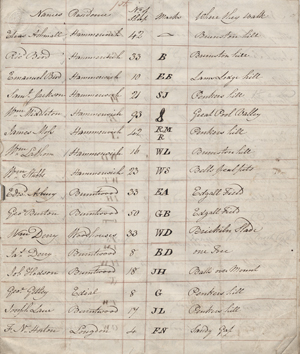
Archive sources
|
Marking of livestock: entitlement to graze sheep on Cannock ChaseExtracts from a register of marks used by smallholders entitled to have livestock on Cannock Chase, 1840s. The area known as Cannock Chase was created in the late 13th century out of the much larger and ancient Cannock Forest, and it was based upon the area of the manors of Cannock and Rugeley, then held by the Bishop of Coventry and Lichfield but granted in the mid-16th century to Lord Paget of Beaudesert. Unless protected by a formal enclosed park, the private lands or private rights of landowners could easily be subject to forms of trespass and theft from the local poorer population. Hence some enclosures were made from the late 16th century. Local residents who held copyhold land from the manor were entitled to certain rights on the Chase, such as grazing cattle and sheep, or taking timber for building or other wood for fuel or fences, although only enough for their own use. A fine was payable by those caught exceeding their rights or having no rights at all. Lord Paget himself had the right to enjoy rabbit warrens and deer. His keepers were kept very busy checking the whereabouts of the deer which tended to roam and roll around in crops. Tension arose with the local population who wanted more land for agriculture. In the 1750s there was a series of riots, when the warrens were attacked and damaged, but it appears that many of the ringleaders had come up from Walsall. From the late 18th century much more of the land was cleared for agriculture, and a breed of sheep native to the Chase was widespread. The Paget estate compiled this register of the number and location of sheep and of the marks used by those who did have proper grazing rights, so that straying or "trespassing" sheep could be identified. A notice was then sent to their owner who had to pay to reclaim them from the pound. Sheep marks were normally kept within families so could remain unchanged for generations, so the initials often do not match the name exactly. A few used pictorial marks such as shears, a key, a horseshoe and a heart. This document also reveals very localised place-names, many of which may now be lost.
|
